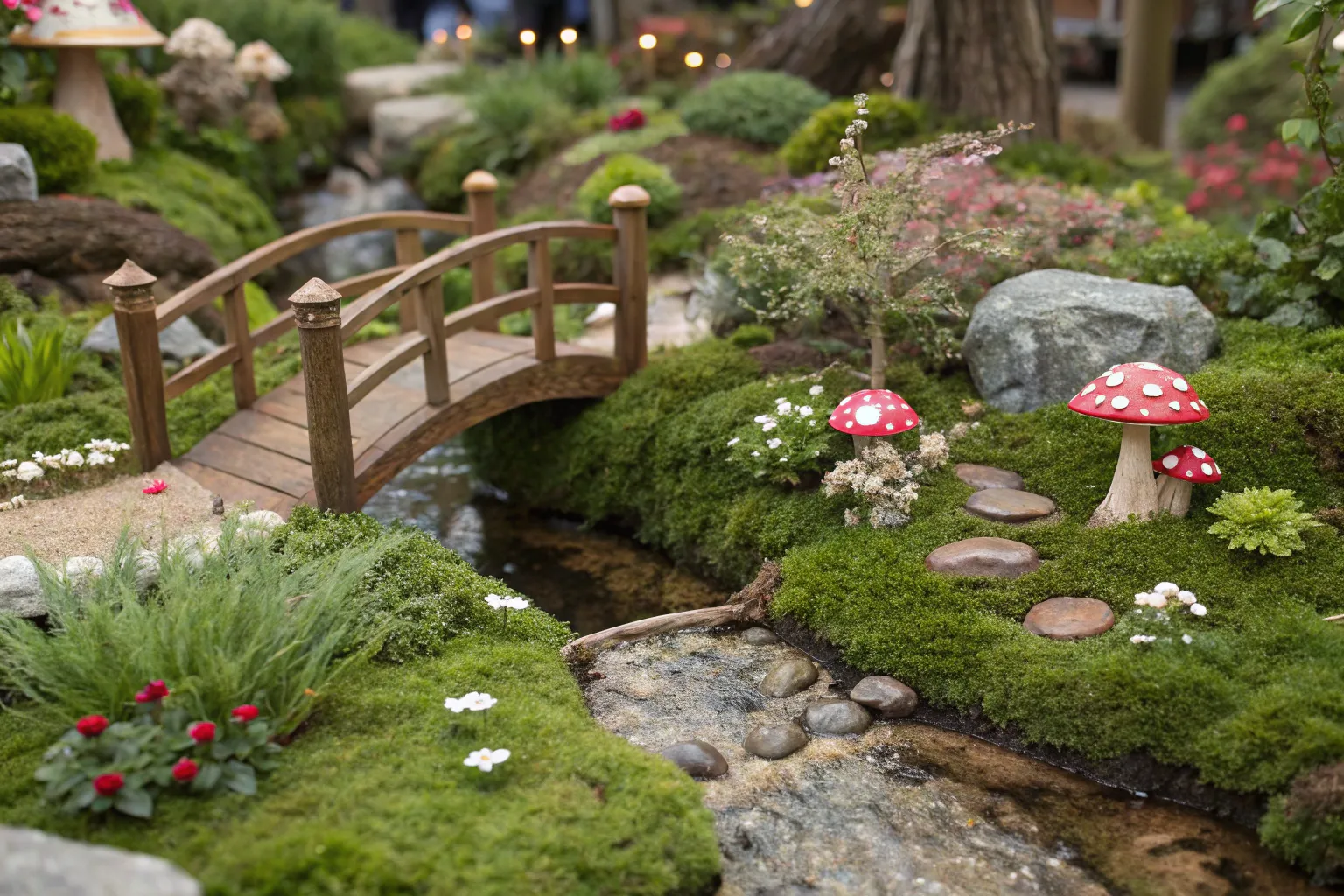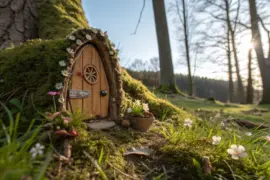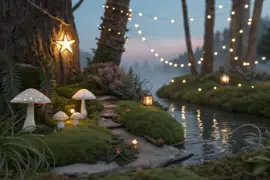Every tiny world begins with a whisper of magic—a moment when imagination takes shape in your hands.
Why We Build Small Worlds

Working in miniature creates something extraordinary: the act of crafting tiny details draws us into a meditative state where we become architects of wonder. When you arrange pebbles into pathways or shape polymer clay into creatures no bigger than your thumbnail, you’re not just making decorations—you’re building portals to other realms. These miniature scenes invite both maker and viewer to pause, peer closer, and discover stories unfolding in spaces small enough to hold in your palm.
The beauty of miniature storytelling lies in its accessibility. Unlike large-scale projects requiring specialized tools or dedicated studio space, fairy gardens and tiny dioramas can emerge from materials already surrounding us: pinecones from the backyard, bottle caps awaiting transformation, twigs that become timber for fairy cottages.
Starting Your Story: Choosing a Theme

Before gathering materials, envision the story your miniature world will tell. Think of your scene as a snapshot—a single magical moment frozen in time.
Consider these storytelling approaches:
The Enchanted Garden: A sun-dappled clearing where fairies tend miniature vegetables, rest in acorn-cap chairs, and gather around a pebble fire pit. This theme emphasizes natural beauty and peaceful coexistence with nature.
The Woodland Cottage: A cozy home nestled against a tree hollow, complete with a moss-covered roof, twig ladder, and tiny laundry line strung between branches. This setting tells stories of domestic fairy life and woodland adventures.
The Secret Hideaway: A mysterious corner tucked behind stones and ferns, hinting at fairy mischief and hidden treasures. Perhaps there’s a tiny door in a tree trunk or a miniature chest overflowing with glass gem “jewels”.
Seasonal Celebrations: Design your scene around a specific time of year—autumn leaves scattered along pathways, winter berry garlands, spring flower markets, or summer picnic scenes.
The theme guides every decision that follows, from color palette to the mood you’ll create through lighting and arrangement.
Building the Scene: Foundation and Structure
Choosing Your Base
Your miniature world needs a foundation that supports both plants (if you’re creating a living garden) and the story you’re telling. Consider these beginner-friendly options:
- Shallow planters or wooden boxes for outdoor fairy gardens
- Decorative trays or old drawers for indoor scenes that can be moved and displayed
- Shoebox dioramas for contained narrative scenes
- Tin containers with drainage holes drilled in the bottom
For larger outdoor gardens, you can save money by filling the bottom third of deep containers with crushed aluminum cans or empty plastic bottles before adding soil—plant roots won’t reach that deep anyway.
Creating Levels and Depth
Flat landscapes lack visual interest, but adding elevation transforms your miniature world. Use broken pot pieces, stacked stones, or built-up soil mounds to create terraced levels. These height changes allow you to position elements at different planes, drawing the eye through the scene and creating that essential sense of depth.
Think about viewpoints: Will your miniature be viewed from all sides or primarily from one angle? Dioramas with one main viewing angle can use techniques borrowed from theater design—placing taller elements toward the back and smaller details in the foreground.
The Rule of Thirds
Borrow this composition principle from photography: Imagine your scene divided into a grid of nine equal sections (three across, three down). Position your main focal point—perhaps the fairy house or a special tree—where these lines intersect rather than dead center. This creates dynamic visual flow that feels natural rather than rigid.
Crafting Fairy Homes

The fairy dwelling serves as your scene’s anchor—the heart of the story.
Building with Natural Materials
Pinecones make spectacular roofing material. Pull apart a large pinecone with pliers and arrange the scales like overlapping tiles on a cone-shaped roof. The natural curves and textures immediately evoke woodland magic.
For walls, consider:
- Birch bark pieces layered like siding
- Small flat stones stacked to create rustic cottages
- Dried gourds hollowed out and painted as rounded fairy homes
- Bundled twigs glued together for a log cabin effect
Moss transforms any structure into something that looks centuries old and naturally integrated into the landscape. Press preserved or living moss onto roofs, around doorways, and at the base of walls.
Simple Construction Method
Start with a basic structure—perhaps a small wood round for the base. Build walls from flat stones or cardboard covered with bark. Create the roof separately as a cone or peaked shape, then attach it to the top. Use strong adhesive like Gorilla Glue rather than hot glue, which dissolves when wet.
Add doors from small wooden craft slices (available at craft stores), stained with wood tones and fitted with tiny brass paper fastener doorknobs. Cut windows from thin twigs arranged as frames.
Recycled Material Houses
Transform everyday items into fairy architecture:
- Plastic bottle caps become planters or tiny tables
- Wooden ice cream spoons craft into modern miniature chairs
- Cardboard boxes become furnished rooms with fabric upholstery
- Clay pots (whole or broken) create instant shelters
The key is training your eye to see ordinary objects at miniature scale. Ask yourself: “What could this become in a tiny world?”
Creating Enchanted Landscapes

Pathways and Ground Cover
Guide the viewer’s eye through your scene with pathways that suggest where fairies walk. Options include:
- Flat wooden rounds (available in craft stores) arranged as stepping stones
- Fine sand raked smooth to create beach-like areas
- Small aquarium pebbles in various colors for defined paths
- Moss carpeting as soft “grass”
Use contrasting textures to define different areas—smooth sand beside rough bark mulch, or glossy glass gems bordering matte stone paths.
Adding Living Elements
For outdoor fairy gardens, select plants that stay small and grow slowly:
- Dwarf conifers and miniature trees that maintain scale
- Succulents offering interesting shapes without overwhelming the scene
- Preserved moss for reliable greenery
- Creeping plants like miniature ivy that spread gently
Remember that living gardens change with the seasons—part of their charm lies in this evolution.
Water Features
Create the illusion of ponds or streams using:
- Blue glass gems or marbles arranged in organic shapes
- Clear resin poured and allowed to cure (adult supervision required for children)
- Mirrors placed beneath stones to suggest reflective water surfaces
- Blue paint on sand, sealed with clear varnish
Textural Details
Layer different materials to build realistic environments. Combine smooth river stones with rough bark, soft moss with spiky twigs, translucent glass elements with opaque clay pieces. This variety of textures catches light differently and adds richness to even the simplest scenes.
Beings & Creatures: Bringing Characters to Life
Every story needs characters, and your miniature world is no exception. These inhabitants bring personality and narrative to your landscape.
Polymer Clay Miniatures
Polymer clay offers the most versatile option for creating custom creatures. This beginner-friendly material (brands include Sculpey and Fimo) remains soft until baked, allowing time to perfect details. Basic shapes—balls, logs, teardrops—combine to form adorable animals and fairy figures.
Simple Clay Creature Tutorial
Start with basic animals like mice, birds, or woodland creatures:
- Roll a ball for the body, slightly elongating one end
- Add a smaller ball for the head
- Create ears from tiny flattened circles
- Roll thin logs for arms and legs, attaching with gentle pressure
- Add details: dots of black clay for eyes, pink for noses
- Use a toothpick to create texture like fur or feathers
- Bake following package instructions (typically 15-20 minutes at 275°F)
- Paint details after cooling if desired
Friendly Characters for All Ages
Focus on cheerful, approachable creatures:
- Butterflies and ladybugs from painted pebbles
- Birds made from pinecone pieces and felt wings
- Friendly gnomes with acorn cap hats
- Mushroom families painted on wood rounds
- Bunnies, hedgehogs, and squirrels in gentle poses
Avoid anything scary or sophisticated—keep the mood whimsical and welcoming.
Found Object Characters
Transform natural materials into instant inhabitants:
- Acorn caps become turtle shells or hats
- Milkweed pods craft into boats with leaf sails
- Walnut shells house tiny fairy babies
- Twig people with seed head faces
Lighting Your Miniature World
Light transforms miniature scenes from charming to enchanting.
Natural Lighting Placement
If photographing your scene or positioning it for display, consider where light naturally falls. Side lighting creates drama and depth, casting shadows that emphasize texture. Light from slightly above mimics sunlight filtering through tree canopy—perfect for fairy garden atmospheres.
Creating Atmosphere Through Light Direction
Think about the story you’re telling: Is this early morning with soft golden light, or mysterious twilight with cooler blue tones? Position your miniature near a window that receives your desired quality of light, or use a desk lamp to create intentional illumination.
For dramatic effect, try uplighting—placing a small light source below your scene to cast interesting shadows upward. This works beautifully with fairy houses, making them glow as if tiny lamps burn inside.
Adding Miniature Lights
Battery-operated fairy lights (those tiny LED strings) tuck beautifully into miniature scenes. Thread them through the landscape, hide the battery pack behind rocks or foliage, and suddenly your scene comes alive with magical sparkle, especially in dimmer room light.
For dioramas, consider drilling tiny holes and inserting individual LED lights to create glowing windows in houses or “fireflies” hovering in your miniature forest.
Understanding Scale and Light
Real light behaves the same in miniature as in full scale, but the effect can feel different. In tiny scenes, even small shadows become dramatic. Use this to your advantage: position important elements where light naturally draws the eye, and let shadows add mystery to background areas.
Working With Scale and Perspective
Scale consistency separates amateur miniatures from professional-looking scenes.
Understanding Common Scales
- 1:12 scale (one inch equals one foot): The most common dollhouse scale, offering excellent detail possibilities
- 1:24 scale (half-inch scale): Smaller but still detailed, good for compact spaces
- 1:48 scale (quarter-inch scale): Tiny but manageable for dedicated crafters
For fairy gardens, strict scale adherence matters less than visual harmony—if everything in your scene relates proportionally to everything else, viewers suspend disbelief.
Mixing Scales Intentionally
You can deliberately use scale variation to create forced perspective, making scenes appear deeper than they physically are. Place larger elements in the foreground and progressively smaller items toward the back. This theatrical technique tricks the eye into perceiving more distance.
Checking Your Proportions
Hold a miniature human figure (if you have one) in your scene periodically while building. Does the doorway accommodate them? Would they reach the tabletop? Can they sit in that chair? This quick check keeps everything in reasonable proportion.
Finishing Touches: The Details That Tell Stories
The smallest details often carry the biggest narrative weight.
Suggesting Activity and Life
Stories live in the evidence of action:
- A tiny basket overflowing with autumn leaves suggests recent harvesting
- A miniature clothesline with fabric scraps implies laundry day
- An open acorn “book” near a toadstool seat shows someone was reading
- A tiny cup near the door suggests tea recently enjoyed
These details invite viewers to imagine what just happened or what might happen next.
Seasonal Transformations
Change small elements with the seasons to keep your miniature world dynamic:
- Spring: tiny flowers, bird nests, pastel colors
- Summer: bright blooms, tiny vegetables, sun-faded fabrics
- Autumn: miniature pumpkins, scattered leaves, golden tones
- Winter: cotton snow, tiny ice skates, berry garlands
Creating Weather and Atmosphere
Suggest environmental conditions through visual cues:
- Wind: Position grasses and tiny fabric flags as if blowing
- Rain: Add glass “puddles” and position umbrellas
- Morning dew: Brush translucent glitter on surfaces
- Frost: Apply white dry-brush paint effects
Adding Movement
Though miniatures are static, you can imply motion:
- Position figures mid-stride rather than standing still
- Angle elements as if responding to breeze or action
- Create paths that curve through the scene, leading the eye on a journey
- Hang elements (birds, lanterns) from fishing line to suggest hovering
Protecting and Preserving Your Miniature World
Outdoor Gardens
Living fairy gardens require regular care:
- Water plants gently to avoid disturbing small elements
- Deadhead flowers (remove spent blooms) to encourage new growth
- Reposition or replace elements damaged by weather
- Bring delicate pieces indoors during harsh weather
Seal painted elements with clear varnish or spray sealant to protect from rain.
Indoor Scenes
Protect indoor miniatures from dust with clear acrylic display cases or glass cloches. These also add an extra layer of enchantment—the miniature world becomes a precious specimen under glass.
Avoid placing scenes in direct sunlight, which can fade colors and warp polymer clay or natural materials over time.
Storytelling Through Your Craft
The most memorable miniature worlds invite questions and spark imagination.
Creating Narrative Tension
Even peaceful scenes can hint at story:
- An empty chair suggests someone just left—where did they go?
- A partially open door invites speculation about what lies within
- A tiny letter propped against a stone prompts questions about its message
Engaging Young Creators
When building miniature worlds with children, emphasize the story over perfection. Ask questions that develop their narrative:
- “Who lives here? What’s their name?”
- “What do they do all day?”
- “What adventure might happen tonight?”
- “Who are their friends?”
These conversations develop storytelling skills and emotional connections to the creation.
Evolving Stories
Leave room for your miniature world to change. Add small surprises periodically: a new resident appears, a note from the “fairies,” a tiny basket of treats. This keeps the magic alive and the story unfolding, especially for children who check their fairy garden regularly to see what happened while they were away.
Gathering Your Materials
Start simple with materials readily available:
From Nature (Free!)
– Pinecones, acorns, seed pods
– Twigs, small branches, bark
– Stones, pebbles, sand
– Moss, lichen, small leaves
– Shells (if near water)
From the Craft Store (Budget-Friendly)
– Polymer clay or air-dry clay
– Wooden rounds and craft sticks
– Strong adhesive (Gorilla Glue or E6000)
– Acrylic paints and brushes
– Small paintbrushes for details
From Around Your Home
– Bottle caps, jar lids
– Fabric scraps for tiny blankets or flags
– Buttons as fairy tables
– Wire for armatures or tiny fences
– Glass beads or marbles
The ‘What Could This Be?’ Game
Train yourself to see miniature potential everywhere. That toothpick? A flagpole. This thimble? A fairy bathtub. Those dried beans? Smooth “stones” for a pathway. This creative vision costs nothing but transforms how you see the world around you.
Embracing Imperfection
I’ve learned that the most magical miniature worlds aren’t the ones where everything aligns perfectly—they’re the ones where you can see the maker’s hands, the slight wobble in the handmade fence, the fingerprint in the clay creature that wasn’t quite smoothed away. These “imperfections” carry warmth and authenticity that mass-produced miniatures lack.
When glue strings show, gently brush them away with an old toothbrush. When paint bleeds past its boundary, incorporate it into weathering and texture. When your fairy house leans slightly, prop it with stones and call it “rustic charm.”
Children especially need permission to create without perfectionism. The wonky mushroom they painted, the lopsided twig fence—these elements make the miniature world truly theirs.





